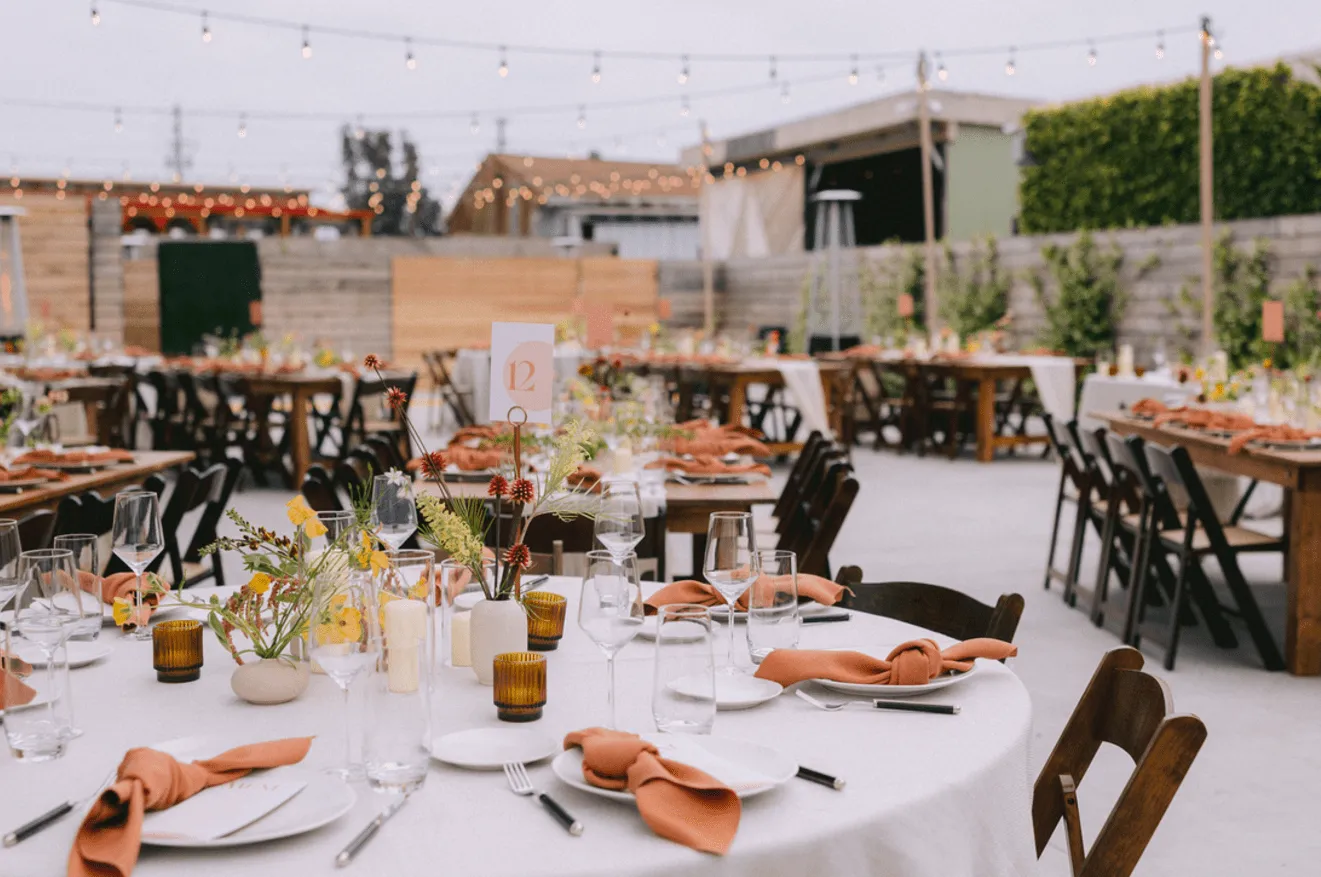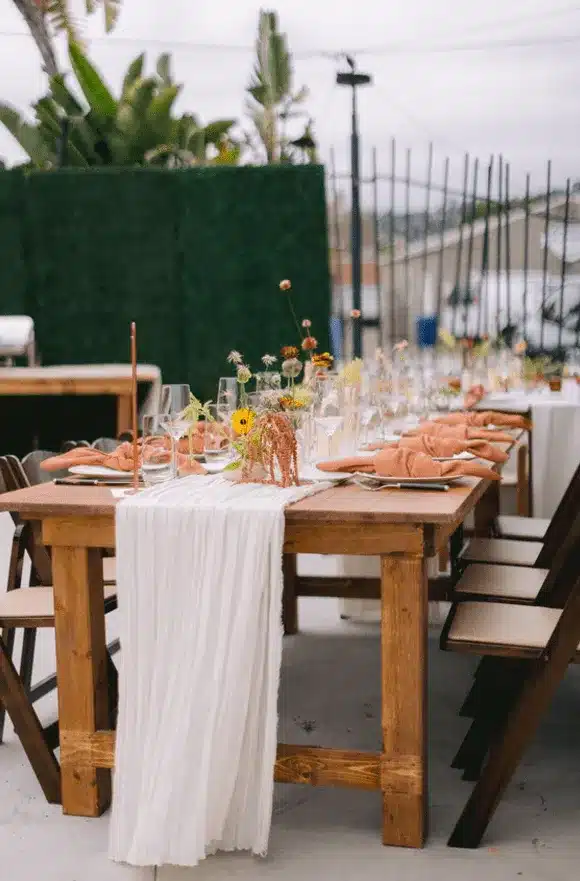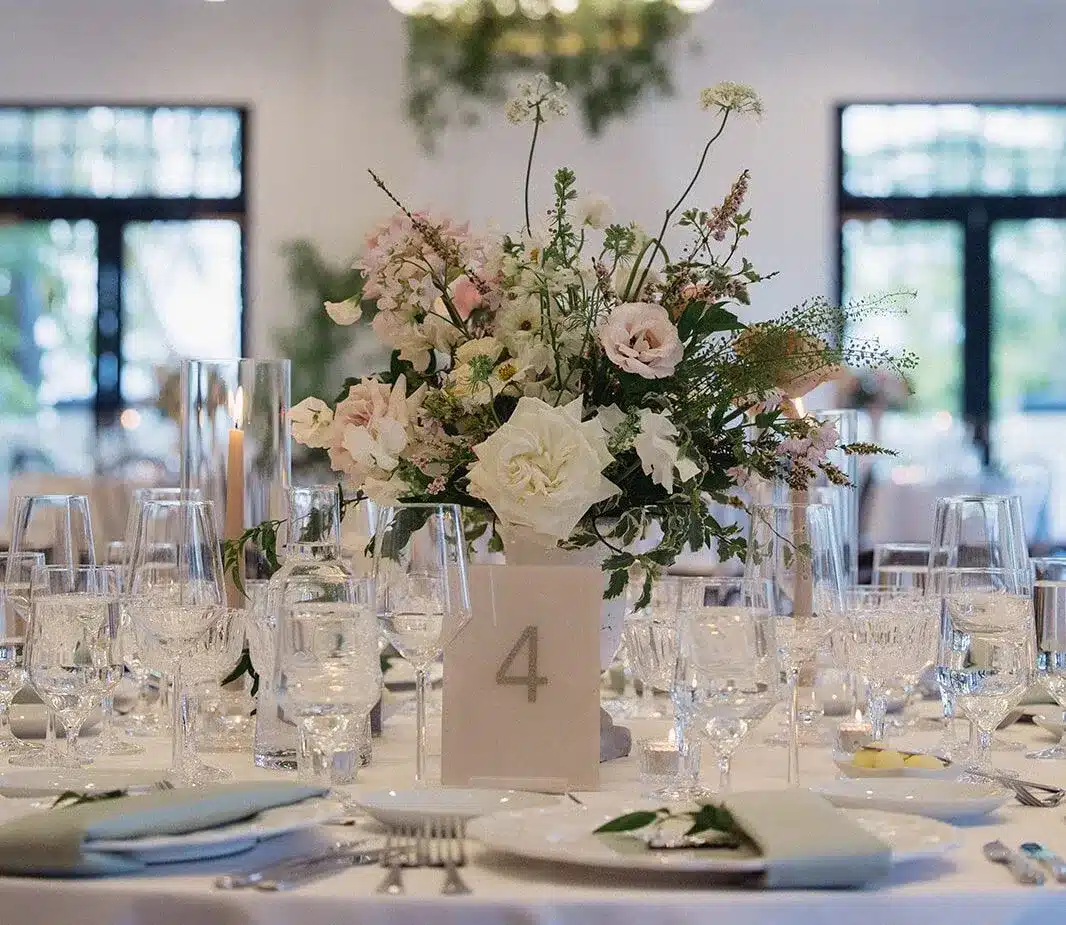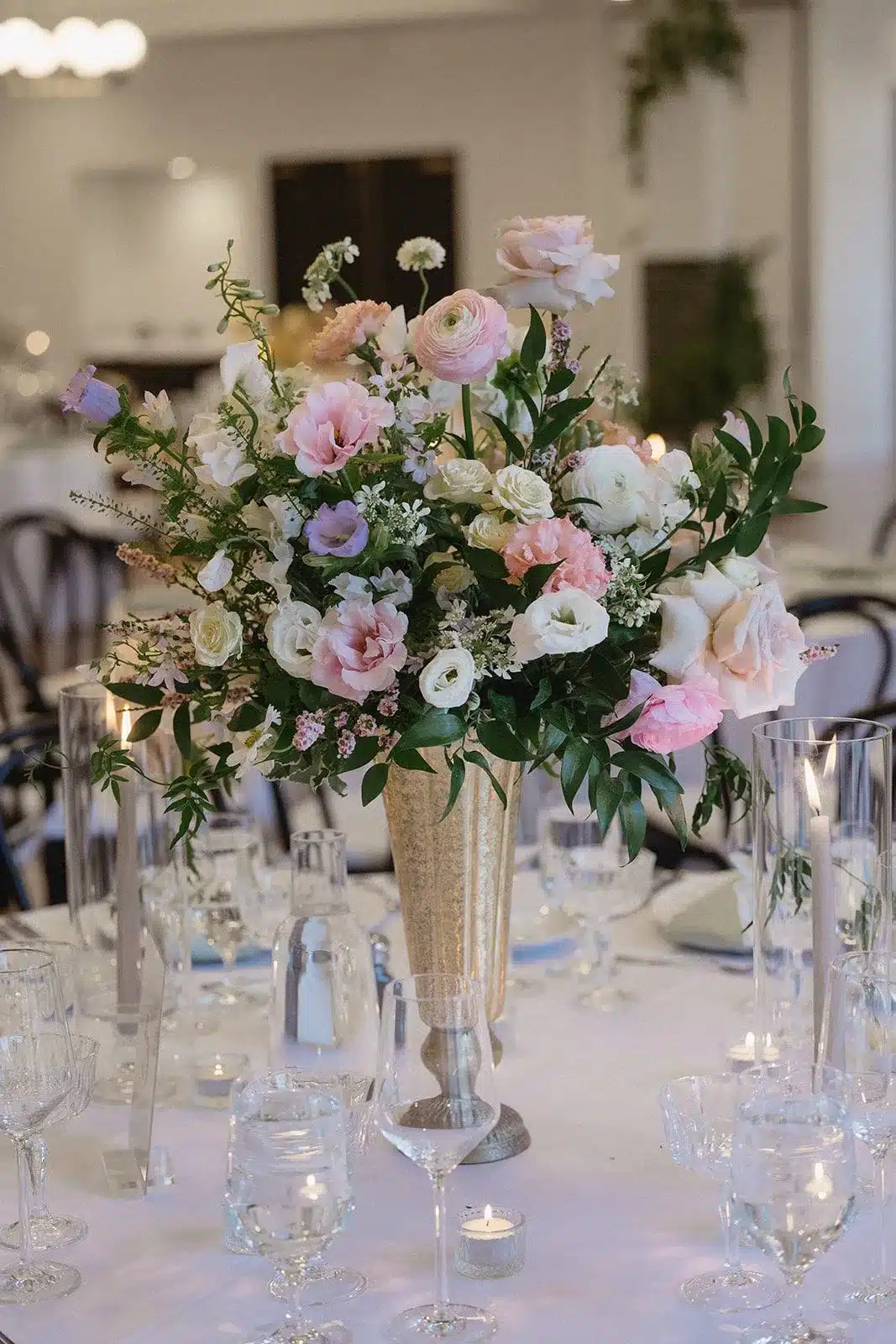Key Takeaways
- Table décor significantly impacts event aesthetics, creating atmosphere and enhancing guest experiences
- Centerpieces, linens, and lighting are crucial elements in crafting cohesive and visually appealing table designs
- Planners adapt décor for different events by using versatile elements and considering themes and audiences
- Sustainable and interactive table décor options are emerging trends in the event planning industry
- Balancing aesthetics with functionality ensures comfortable and practical table settings for guests
Understanding the Significance of Table Décor in Events

Table décor plays a crucial role in shaping event aesthetics. From the emotional impact of table settings to the use of colors and textures, each element contributes to the overall atmosphere. Thoughtful arrangements, including candelabras and candlesticks, can elevate theme consistency while staying within budget. Whether it’s a honeymoon celebration or a cotton-themed party, balancing these components creates visually appealing and memorable table designs.
The Emotional Influence of Table Settings
Table settings evoke powerful emotions, shaping the atmosphere of events like weddings. A well-designed table with a centerpiece tree or elevated pedestal can create a sense of wonder and elegance. The careful arrangement of place settings, including drink placement, influences guests’ perceptions and experiences throughout the event. By thoughtfully combining elements, event planners can craft table settings that resonate with attendees and enhance the overall emotional impact of the occasion.
How Colors Impact Event Atmosphere
Colors play a pivotal role in shaping the atmosphere of events, influencing guests’ emotions and perceptions. Vibrant hues can energize a space, while muted tones create a sense of elegance and sophistication. For instance, incorporating satin table linens in soft pastels can evoke a romantic ambiance, perfect for weddings. Metallic accents, such as Eiffel tower centerpieces or wax candles in metal holders, add depth and visual interest to table settings. When paired with a beautifully decorated cake as a focal point, these elements work together to create a cohesive and memorable event aesthetic.
The Role of Texture in Creating Visual Interest
Texture adds depth and visual interest to table décor, transforming event spaces into captivating environments. From smooth poly tablecloths to intricate macramé runners, texture creates contrast and dimension. Incorporating elements like sequin overlays or balloon centerpieces can elevate the tactile experience while accounting for the overall theme. By skillfully combining different textures, event planners can craft visually stunning and memorable table settings that engage guests’ senses and enhance the event’s aesthetic appeal.
Elevating Theme Consistency Through Table Décor
Table décor serves as a powerful tool for elevating theme consistency in events. Event planners can reinforce a brand’s identity by incorporating logos into menu cards or using laser-cut placeholders. Fairy lights intertwined with centerpieces create a magical atmosphere that aligns with the event’s theme. By carefully selecting elements that reflect the overall concept, from table linens to decorative accents, organizers ensure a cohesive and memorable experience for guests.
The Importance of Balance in Table Arrangements
Achieving balance in table arrangements is essential for creating visually appealing and functional event spaces. Event planners must carefully consider the proportions of centerpieces, linen choices, and tableware to ensure harmony. For wedding receptions, balancing elegant wine glasses with plastic or resin decorative elements can create a sophisticated yet practical setting. The strategic placement of these items, along with thoughtfully chosen table linens, contributes to a well-balanced and inviting atmosphere that enhances the overall guest experience.
Essential Elements of Effective Table Décor

Effective table décor enhances event aesthetics through carefully chosen elements. Selecting the right table linens, eye-catching centerpieces, and strategic lighting transforms settings. Tableware and place settings reflect event style and impact guest experience. From floral designs to crystal accents, each component plays a crucial role. A well-stocked cart of décor ideas helps event planners create stunning table arrangements that leave lasting impressions.
Choosing the Right Table Linens for Enhanced Aesthetics
Selecting the right table linens enhances event aesthetics and sets the foundation for a cohesive décor scheme. Event planners can use a shopping cart to gather various linen options, including tablecloths, runners, and napkins. Wood-inspired linens add warmth, while LED-lit table covers create a modern ambiance. The centrepiece choice often dictates linen color and texture, ensuring a harmonious look. When planners shop for linens, they consider factors such as:
- Event theme and color palette
- Venue style and existing décor
- Season and time of day
- Table shape and size
- Budget constraints
Selecting Centerpieces That Capture Attention
Centerpieces are pivotal in capturing guests’ attention and setting the tone for an event. Event planners can create stunning focal points by incorporating fruit, champagne, and plants into their designs. For a summer party, a vibrant fruit arrangement paired with chilled champagne bottles creates a refreshing and inviting atmosphere. Alternatively, using potted plants as centerpieces adds a touch of nature and sustainability to the table design, appealing to eco-conscious guests.
Incorporating Lighting to Transform Table Settings
Lighting plays a crucial role in transforming table settings and enhancing event aesthetics. For birthday celebrations or outdoor tent events, strategic lighting can create a captivating atmosphere and define the space. Event planners often use colorful LED lights to accent centerpieces or illuminate table linens, adding depth and dimension to the overall design. By incorporating various lighting elements, such as candles, string lights, or uplighting, event professionals can dramatically alter the mood and ambiance of any table setting.
Using Tableware to Reflect Event Style
Tableware serves as a powerful tool for reflecting event style and enhancing the overall aesthetic. Event planners can use silk tablecloths to create an elegant foundation, complemented by silver cutlery and crystal glasses for a luxurious touch. For a modern look, sleek white plates paired with spandex chair covers can create a streamlined appearance. By carefully selecting tableware that aligns with the event’s theme and atmosphere, planners can create a cohesive and visually appealing table setting that leaves a lasting impression on guests.
The Impact of Place Settings on Guest Experience
Place settings significantly impact guest experience, reflecting the event’s design and attention to detail. Event planners carefully curate each element, from the placement of cupcakes to the positioning of votive candles, to create a cohesive look. A well-designed place setting might include a neon sign as a unique place card, adding a modern touch to the table. These thoughtful arrangements encourage guests to engage with their surroundings and feel valued. Planners often use an “add to cart” approach, selecting items that complement the overall aesthetic:
- Charger plates
- Flatware
- Glassware
- Napkins and napkin rings
- Place cards or menu cards
Creating Cohesive Themes With Table Décor
Table décor plays a crucial role in creating cohesive themes for events. Event planners align table designs with the event’s purpose, considering seasonal influences and cultural elements. They integrate branding into table settings and choose décor items that tell a story. By carefully selecting napkins, tea settings, and other elements, planners create an atmosphere that resonates with customers and enhances the overall event table experience.
Aligning Table Design With Event Purpose
Event planners align table designs with the event’s purpose to create cohesive themes. For outdoor ceremonies, they might use iron tables with leaf-shaped placemats, complemented by glass centerpieces filled with natural elements. Picnic-style events call for rustic table settings, incorporating wooden accents and wildflower arrangements. By carefully selecting décor elements that reflect the event’s purpose, planners create a harmonious atmosphere that enhances the overall guest experience:
- Formal galas: Elegant tablecloths, crystal stemware, and silver candelabras
- Beach weddings: Sand-filled glass vases, seashell accents, and blue table linens
- Corporate events: Branded table runners, sleek centerpieces, and minimalist place settings
- Garden parties: Floral tablecloths, terracotta pot centerpieces, and herb-infused water glasses
Seasonal Themes and Their Influence on Table Décor
Seasonal themes significantly influence table décor, allowing event planners to create immersive experiences that reflect the time of year. In autumn, warm-toned tableware pairs with candle-lit centerpieces and leaf garlands to evoke a cozy atmosphere. Summer events feature light, airy designs with paper lanterns and vibrant floral arrangements. Winter table settings often incorporate sparkling elements, such as crystal candle holders and metallic accents, while spring décor embraces pastel hues and fresh blooms. By aligning table décor with seasonal themes, planners create cohesive and memorable event aesthetics:
| Season | Table Décor Elements |
|---|---|
| Spring | Pastel linens, floral centerpieces, butterfly accents |
| Summer | Bright colors, fruit displays, paper lanterns |
| Autumn | Rustic textures, leaf garlands, pumpkin centerpieces |
| Winter | Metallic accents, pine cones, crystal candle holders |
Cultural Considerations in Table Aesthetics
Cultural considerations play a vital role in table aesthetics, influencing event design across various occasions. For corporate events, planners incorporate cultural elements into centerpieces and table settings to reflect the company’s global reach. Bridal showers often feature culturally significant decorations, such as traditional patterns or symbols, on napkins and tablecloths. Photo booths with cultural backdrops complement the table décor, creating a cohesive theme. Event planners may use arches adorned with culturally inspired elements to frame the bride’s table, enhancing the overall aesthetic and honoring heritage.
Integrating Branding Into Table Designs
Event planners integrate branding into table designs to create cohesive themes that reinforce corporate identity. They incorporate company logos on velvet table runners and use branded lanterns as centerpieces. Bridesmaids’ tables often feature custom textiles that match the wedding’s color scheme. Catering teams collaborate with planners to ensure that even food presentation aligns with the brand’s aesthetic. The strategic use of branded elements in table décor creates a unified and memorable experience for guests:
| Branded Element | Table Décor Application |
|---|---|
| Company Logo | Embroidered napkins, etched glassware |
| Color Scheme | Coordinated linens, floral arrangements |
| Tagline | Printed menu cards, table signage |
| Brand Imagery | Custom centerpieces, place card holders |
Choosing Décor Items That Tell a Story
Event planners select décor items that tell a story, creating memorable experiences for guests. For corporate events, they might use a crystal vase filled with roses to symbolize growth and elegance. Lace-wrapped columns can evoke a sense of tradition and craftsmanship, while customized centerpieces reflect the company’s journey or values. By carefully curating these elements, planners craft cohesive themes that resonate with attendees:
- Vintage photographs in antique frames to showcase company history
- Locally sourced materials to highlight community connections
- Interactive displays that evolve throughout the event
- Themed table numbers that relate to company milestones
- Personalized favors that tie into the event’s narrative
Practical Tips for Stunning Table Décor

Event planners can create stunning table décor using practical tips and creativity. From DIY ideas for budget-friendly designs to sourcing unique items, layering elements, and applying Feng Shui principles, these techniques enhance event aesthetics. Incorporating sustainability in décor choices adds value. Whether in a barn setting with manzanita branches or a marquee adorned with chandeliers, these tips help craft memorable table arrangements that complement floristry and elevate the overall event experience.
DIY Ideas for Budget-Friendly Table Décor
Event planners use DIY ideas to create budget-friendly table décor that impresses guests without breaking the bank. They repurpose everyday items, such as mason jars filled with fairy lights, as centerpieces. Handmade place cards using calligraphy on leaves or stones add a personal touch. Planners often create custom table runners using inexpensive fabric and stencils, matching the event’s theme. These DIY approaches not only save money but also allow for unique, tailored designs that enhance the overall aesthetic:
| DIY Idea | Materials | Effect |
|---|---|---|
| Floating candle centerpieces | Glass bowls, water, floating candles | Elegant, romantic ambiance |
| Succulent favors | Small pots, succulents, decorative pebbles | Eco-friendly, long-lasting keepsakes |
| Photo table numbers | Printed photos, cardstock, glue | Personalized, nostalgic touch |
| Origami napkin folds | Cloth napkins | Artistic, conversation-starting detail |
Sourcing Unique Items for Personalized Touch
Event planners source unique items to add a personalized touch to table décor. They scour antique shops for vintage china or repurpose family heirlooms as centerpieces. Local artisans often provide handcrafted elements, such as custom-made place card holders or themed table numbers. Planners might incorporate region-specific items to reflect the event’s location or cultural significance. These unique touches create memorable experiences for guests and enhance the overall aesthetic:
| Unique Item | Source | Personal Touch |
|---|---|---|
| Vintage books | Thrift stores | Literary-themed centerpieces |
| Handwoven baskets | Local artisans | Cultural authenticity |
| Antique keys | Flea markets | Whimsical place card holders |
| Custom-printed tiles | Local print shops | Personalized coasters |
Layering Elements for Depth and Dimension
Event planners create depth and dimension in table décor by skillfully layering elements. They start with a base layer of textured linens, then add charger plates, dinner plates, and smaller accent dishes. Centerpieces of varying heights, such as tall floral arrangements paired with low votives, create visual interest. Planners often incorporate table runners or overlays in complementary colors or patterns to add another layer of texture. This thoughtful layering approach results in a rich, multi-dimensional tablescape that captivates guests and enhances the overall event aesthetic.
Feng Shui Principles for Harmonious Table Arrangements
Event planners apply Feng Shui principles to create harmonious table arrangements that enhance the overall energy of the space. They position tables to allow easy flow of movement and ensure guests feel comfortable and secure. Planners use balanced color schemes and incorporate natural elements like plants or water features to promote positive energy. The careful placement of centerpieces and table settings follows Feng Shui guidelines, creating a sense of balance and harmony that contributes to a positive event atmosphere:
- Arrange tables in a circular or octagonal pattern to promote conversation
- Use round or oval tables to encourage smooth energy flow
- Incorporate the five elements (wood, fire, earth, metal, water) in décor
- Avoid sharp edges or pointed objects that create negative energy
- Balance yin and yang elements through color and texture choices
Sustainability in Table Décor Choices
Event planners increasingly prioritize sustainability in table décor choices, aligning with eco-conscious trends. They opt for reusable centerpieces, such as potted plants or succulent arrangements, which guests can take home and enjoy long after the event. Biodegradable or compostable tableware replaces traditional disposables, reducing environmental impact. Planners source locally produced, organic linens and incorporate upcycled materials into table designs, creating unique and environmentally friendly aesthetics.
Frequently Asked Questions About Table Décor

Event planners often encounter questions about table décor. This section addresses key elements of effective designs, adapting décor for various events, budgeting considerations, ensuring functionality, and upcoming trends. These insights help planners create stunning table arrangements that enhance event aesthetics while meeting practical needs and staying within budget constraints.
What Are the Key Elements of Effective Table Décor?
Effective table décor comprises several key elements that work together to create a cohesive and visually appealing design. These include a well-chosen centerpiece that serves as a focal point, complementary linens that set the foundation for the overall look, and appropriate lighting to enhance the ambiance. Event planners also consider the balance of colors, textures, and heights in their table arrangements, ensuring that each element contributes to the desired aesthetic without overwhelming the space. Additionally, thoughtful placement of tableware, such as plates, cutlery, and glassware, plays a crucial role in both functionality and style, completing the overall table décor.
How Can I Adapt My Table Décor for Different Events?
Event planners adapt table décor for different events by considering the occasion’s purpose, theme, and audience. They select versatile centerpieces that can be easily modified with seasonal accents or color changes to suit various events. Linens play a crucial role in transformation; planners often use neutral base tablecloths and add colorful runners or overlays to match specific themes. By focusing on adaptable elements and investing in multipurpose décor items, planners create flexible table designs that can be easily customized for weddings, corporate gatherings, or seasonal celebrations.
What Is the Average Budget for Table Décor Per Guest?
The average budget for table décor per guest typically ranges from $20 to $50, depending on the event type and scale. Event planners often allocate 10-15% of the total event budget to table décor, adjusting this amount based on the client’s priorities and the desired aesthetic impact. For more elaborate designs or high-end events, this figure can increase to $75-$100 per guest, while budget-conscious planners may achieve impressive results with $15-$25 per person by using creative DIY solutions and cost-effective rental options.
How Can I Ensure My Table Décor Is Functional?
Event planners ensure functional table décor by carefully considering guest comfort and practical needs. They arrange centerpieces and decorative elements to allow clear sightlines and easy conversation across the table. Planners also select appropriate table sizes and shapes to accommodate the required place settings, ensuring ample elbow room for guests. Functional table décor includes easily accessible condiments, water pitchers, and other essentials, strategically placed to minimize disruptions during the event. By balancing aesthetic appeal with practicality, planners create table settings that not only look stunning but also enhance the overall guest experience.
What Are Some Trends in Table Décor for Upcoming Events?
Event planners are embracing several emerging trends in table décor for upcoming events. Sustainable and eco-friendly options are gaining popularity, with planners incorporating living centerpieces, such as potted herbs or succulents, that guests can take home and enjoy long after the event. Textured linens, including velvet and macramé, are adding depth to table designs, while mixed metallic accents create a luxurious yet modern feel. Interactive table elements, such as built-in charging stations or augmented reality place cards, are enhancing guest engagement and reflecting the increasing integration of technology in event experiences.
Conclusion
Table décor plays a pivotal role in shaping event aesthetics, creating immersive experiences that leave lasting impressions on guests. From weddings to corporate gatherings, thoughtfully designed table settings enhance the overall atmosphere, reflecting themes, brands, and cultural elements while engaging attendees on multiple sensory levels. Event planners leverage a combination of centerpieces, linens, lighting, and personalized touches to craft cohesive and visually stunning table arrangements that align with event objectives and budgets. By mastering the art of table décor, professionals can transform ordinary spaces into extraordinary environments, elevating the perceived value of events and creating memorable moments for all participants.






